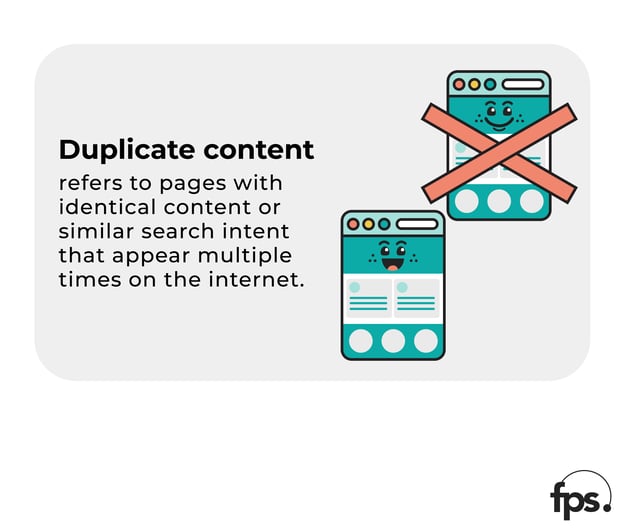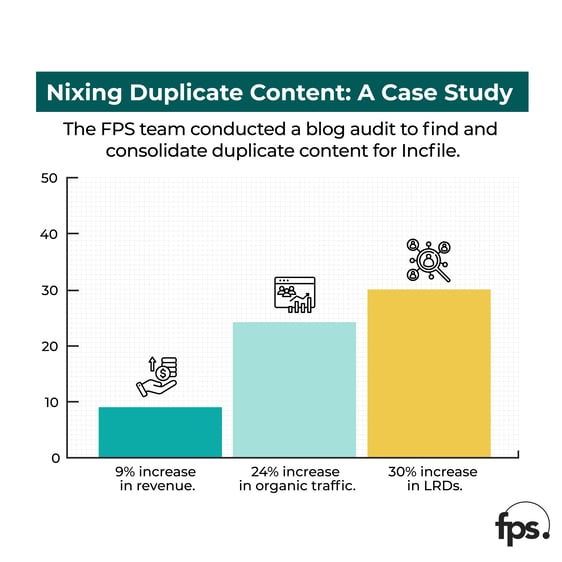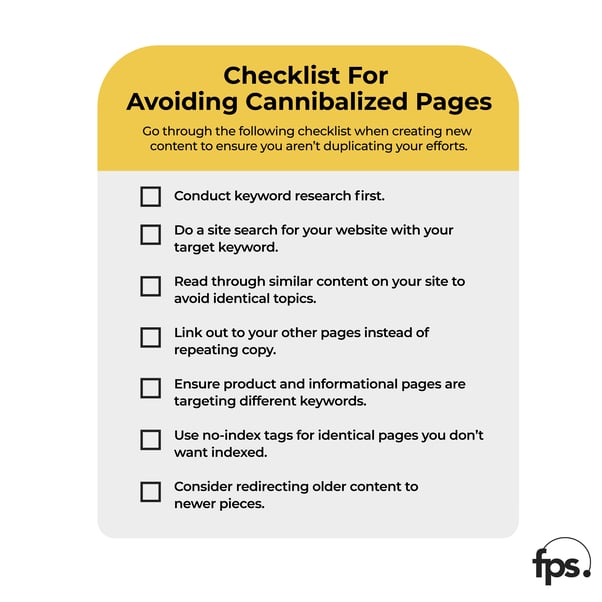If you’ve ever watched a true crime documentary or Netflix’s “Dahmer,” you know how horrifying a cannibal can be. But what if I told you that there was another type of cannibal you need to be worried about — one that may not be as gory but can cause damage all the same?
Duplicate content is its own type of serial killer, gobbling up your ability to perform well in search and causing a host of other issues that will degrade your website's overall health. Below, we cover everything you need to know about content cannibalization, including how to spot it in the wild and stop it in its tracks.
What Is Duplicate Content?
Duplicate content refers to identical (or almost identical) pieces of content that live on multiple pages on the internet — either on the same domain or separate domains.

Your website can experience duplicate content through no fault of your own, as many third-party websites like to find and scrape content from other sources and post it as their own.
However, you can also experience accidental cannibalization through your own content. We’ve seen this issue arise with clients that have too much content, muddled internal communication, or multiple teams churning out content at once. It only takes one person or team not doing their research to render both pieces of content null!
But no matter how it happens, finding and flagging duplicate content is key to maintaining your website’s overall health and search performance.
Why Is Having Duplicate Content an Issue for SEO?
Duplicate content is an issue for SEO because Google wants to prioritize unique content that serves the best possible results to users.
It makes sense if you consider it from a user perspective — how can you trust a website that seems to be copying and pasting information from other sources on the web (or just repeating their old copy and passing it off as new)? How do you know who was the original owner of the content and who is the copycat?
While specific duplicate content penalties are one of the bigger SEO myths squashed in recent years, that doesn’t mean you should keep copycat content on your website.
Having identical content (or even content with similar search intent) can confuse Google, making it difficult to appear high on the SERP for your target keyword. This means you won’t get in front of the users that are searching for your topic, leading to less organic traffic and fewer conversion opportunities over time.
Incfile Case Study: How We Increased Traffic by Deleting Content
Thankfully, duplicate content is an issue that can be easily remedied. In fact, we saw great results for our client, Incfile, by focusing on deleting content rather than creating it. By trimming the fat, we were able to boost Incfile’s authority, which in turn increased rankings and overall traffic in just a few short months.

Here’s a breakdown of how we tackled cannibalization issues for Incfile and how this project moved the needle.
1. Conducted Content Audit
In order to understand what cannibalization issues we were dealing with, we first had to conduct a content and SEO audit. We used Screaming Frog to pull all the blog URLs for Incfile, and then we began analyzing each one.
During this analysis, we clarified the topic, title, target keyword, and product tie-in for every single post (Incfile had over 1,000 blog posts — so it's safe to say it took a while). Once we better understood what each post was about and what keywords they were targeting, we were able to move to step number two: analyzing duplicates and determining the move-forward plan.
2. Analyzed Duplicates + Determined Next Steps
During this stage, we looked at the traffic and current rankings for every blog post. If the post was doing well, wasn’t too old, and was still relevant to Incfile’s brand, we recommended they keep it. We also recommended deleting posts that were very old and no longer topically relevant.
Content with similar search intent was given redirect and/or consolidation recommendations. And lastly, any content that was valuable to users but not ranking well was tagged as needing a rewrite.
Out of the nearly 1,000 blog posts, we recommended that Incfile:
- Keep about 400 of them as-is
- Delete over 100 posts
- Redirect 70 pieces of content to similar pages
- Rewrite the remaining 400 articles
These recommendations helped to ensure they didn’t lose any valuable traffic or rankings and that similar content was condensed in a way that helped users find the information they needed.
3. Optimized Content
After the analysis, we moved on to the implementation stage.
Our SEO team got to work setting up the necessary redirects and trimming content we deemed no longer necessary. To prevent any 404 errors, we also set up redirects from all deleted content to the blog homepage and removed any internal links to those pages throughout the site.
On the content side, we began to slate these rewrites into our regular content calendar. By tackling at least a dozen SEO-friendly rewrites a month with low-difficulty and high-volume keywords, we boosted older content back up the SERP, getting our client in front of more eyeballs than ever before.
4. Watched Traffic Soar
Now comes the fun part — watching the fruits of our labor!
We all know that seeing changes on the SERP takes time. But one of the benefits of rewriting an older piece of content is that you can expect rankings to jump faster than you would with a brand-new piece of content.
Within six months of starting our rewriting and consolidation efforts, our client Incfile saw a:
- 9% increase in blog revenue
- 24% increase in organic blog traffic
- 30% increase in linking root domains (LRDs) to the blog
And keep in mind that these numbers are just the beginning. With more time and additional rewrites slated in, Incfile will see these numbers continue to rise.
SEO Best Practices to Avoid Cannibalization
If you feel your site needs a cannibalization audit but don’t know where to start, we’ve got you covered. Follow the checklist below to find and fix any duplicate content for your brand:
- Conduct keyword research first.
- Do a site search for your website with your target keyword.
- Read through similar content on your site to avoid identical topics.
- Link out to your other pages instead of repeating copy.
- Ensure product and informational pages are targeting different keywords.
- Use no-index tags for identical pages you don’t want to be indexed.
- Consider redirecting older content to newer pieces.

Don’t have the time, expertise, or bandwidth to tackle a big content audit? That’s where we come in. Learn how we can help you achieve long-term, sustainable growth.







